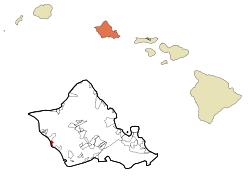- Mā'ili, Hawai'i
-
Maili, Hawaii — CDP — Location in Honolulu County and the state of Hawaii Coordinates: 21°25′6″N 158°10′43″W / 21.41833°N 158.17861°WCoordinates: 21°25′6″N 158°10′43″W / 21.41833°N 158.17861°W Country United States State Hawaii Area - Total 2.0 sq mi (5.3 km2) - Land 1.0 sq mi (2.5 km2) - Water 1.1 sq mi (2.8 km2) Elevation 0 ft (0 m) Population (2000) - Total 5,943 - Density 6,241.5/sq mi (2,409.9/km2) Time zone Hawaii-Aleutian (UTC-10) Area code(s) 808 FIPS code 15-47300 GNIS feature ID 0361999 Māʻili is a town and census-designated place (CDP) in the Waiʻanae District on the Island of Oʻahu, City & County of Honolulu, Hawaiʻi. In Hawaiian, māʻili means "pebbly" referring to rounded stones at the shore. As of the 2000 Census, the CDP population was 5,943.
Contents
Geography
Māʻili is located at 21°25′6″N 158°10′43″W / 21.41833°N 158.17861°W (21.418333, -158.178736)[1].
According to the United States Census Bureau, the CDP has a total area of 2.0 square miles (5.2 km2), of which, 0.9 square miles (2.3 km2) of it is land and 1.1 square miles (2.8 km2) of it (53.43%) is water.
Demographics
As of the census[2] of 2000, there were 5,943 people, 1,359 households, and 1,178 families residing in the CDP. The population density was 6,241.5 people per square mile (2,415.4/km²). There were 1,502 housing units at an average density of 1,577.5 per square mile (610.4/km²). The racial makeup of the CDP was 11.07% White, 0.91% African American, 0.24% Native American, 22.56% Asian, 23.89% Pacific Islander, 1.09% from other races, and 40.23% from two or more races. Hispanic or Latino of any race were 14.67% of the population.
There were 1,359 households out of which 42.3% had children under the age of 18 living with them, 58.9% were married couples living together, 19.8% had a female householder with no husband present, and 13.3% were non-families. 9.5% of all households were made up of individuals and 3.8% had someone living alone who was 65 years of age or older. The average household size was 4.22 and the average family size was 4.35.
In the CDP the population was spread out with 35.0% under the age of 18, 10.4% from 18 to 24, 27.2% from 25 to 44, 18.4% from 45 to 64, and 9.0% who were 65 years of age or older. The median age was 28 years. For every 100 females there were 103.0 males. For every 100 females age 18 and over, there were 98.3 males.
The median income for a household in the CDP was $45,786, and the median income for a family was $48,068. Males had a median income of $33,229 versus $21,211 for females. The per capita income for the CDP was $13,185. About 19.3% of families and 21.5% of the population were below the poverty line, including 28.3% of those under age 18 and 9.1% of those age 65 or over.
Education
Hawaii Department of Education operates public schools. Maili Elementary School is located in the CDP.[3]
References
- ^ "US Gazetteer files: 2010, 2000, and 1990". United States Census Bureau. 2011-02-12. http://www.census.gov/geo/www/gazetteer/gazette.html. Retrieved 2011-04-23.
- ^ "American FactFinder". United States Census Bureau. http://factfinder.census.gov. Retrieved 2008-01-31.
- ^ "Maili CDP, Hawaii." U.S. Census Bureau. Retrieved on May 21, 2009.
Municipalities and communities of Honolulu County, Hawaii County seat: Honolulu CDPs Ahuimanu | Aiea | 'Ewa Beach | 'Ewa Gentry | Ewa Villages | Halawa | Hale'iwa | Hau'ula | He'eia | Honolulu | Iroquois Point | Kaʻaʻawa | Kahaluu | Kahuku | Kailua | Kalaeloa | Kaneohe | Kawela Bay | Laie | Mā'ili | Mākaha | Mākaha Valley | Makakilo | Marine Corps Base Hawaii | Maunawili | Mililani | Mokulē'ia | Nānākuli | North Ko'olaupoko | Pearl City | Punalu'u | Pūpūkea | Schofield Barracks | Village Park | Wahiawā | Waialua | Wai'anae | Waimalu | Waimanalo Beach | Waimānalo | Waipahu | Waipi'o Acres | Waipio | Whitmore Village
Unincorporated
communitiesAina Haina | Hawaii Kai | Kaimuki | Kapolei | Kunia Camp | Palolo | Pauoa | Waimea Bay
Categories:- Neighborhoods in Honolulu, Hawaii
- Census-designated places in Honolulu County, Hawaii
- Populated places on Oahu
Wikimedia Foundation. 2010.


